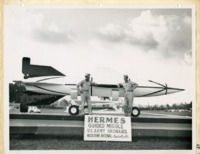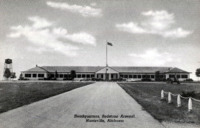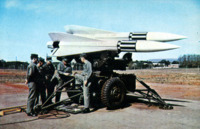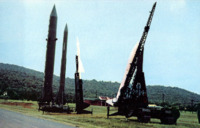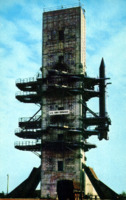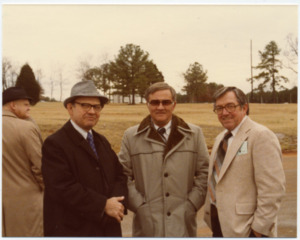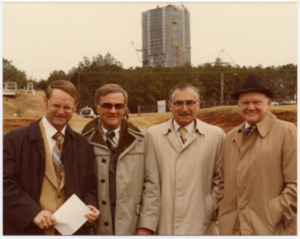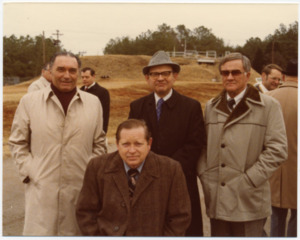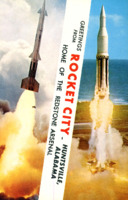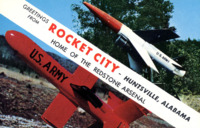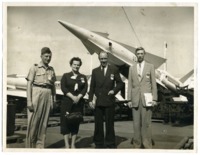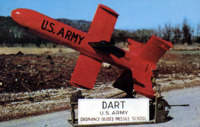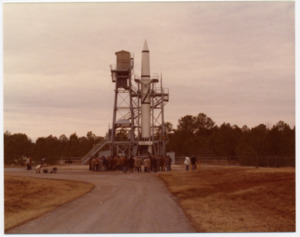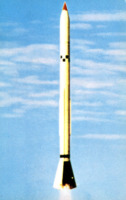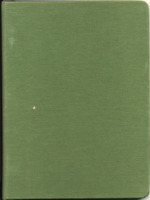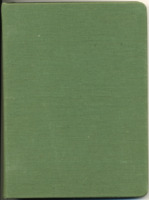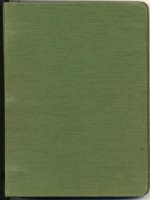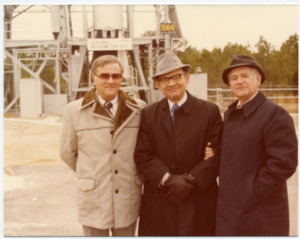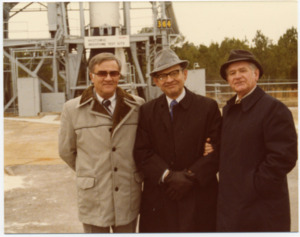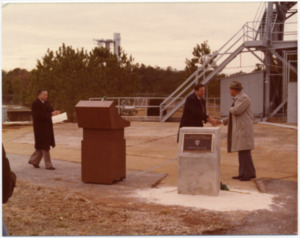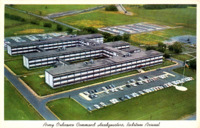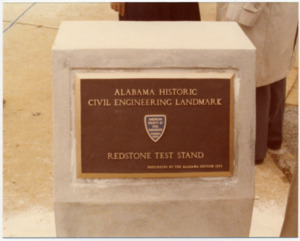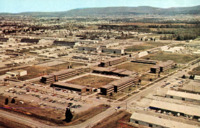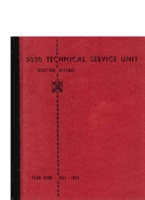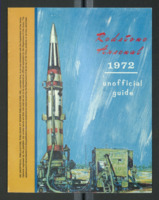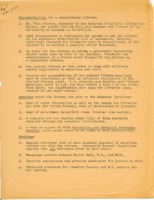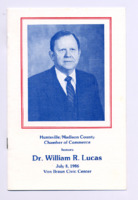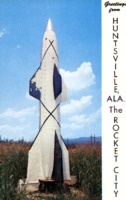
Browse Items (74 total)
Sort by:
-
Hermes guided missile on display.
The sign in front of the missile reads, "Hermes Guided Missile, U.S. Army Ordnance, Redstone Arsenal, Huntsville, Ala." -
Headquarters, Redstone Arsenal
Front: Headquarters, Redstone Arsenal, Huntsville, Alabama. -
Hawk Anti-Aircraft Missile
Back: Field exercise maintainance of Hawk anti-aircraft missile at Missile and Munitions Center and School at Redstone Arsenal near Huntsville, Ala. -
Guided Missiles
Back: THE REDSTONE, CORPORAL, NIKE-AJAX AND HONEST JOHN GUIDED MISSILES REDSTONE ARSENAL, HUNTSVILLE, ALABAMA. Redstone Arsenal is the Army Ordnance research and development center for rockets and guided missiles. It is here where the army developed its guided missiles, including the mighty Jupiter C, which launched the Explorer, the United States first Earth Satellite. -
Guided Missile Test Tower with Redstone Missile
Back: GUIDED MISSILE TEST TOWER WITH REDSTONE MISSILE, REDSTONE ARSENAL, HUNTSVILLE, ALABAMA
This is the largest static firing test stand for rocket motors in the U. S., and possibly in the world. The huge Army facility, costing $12,000,000. towers 145 feet high-as tall as a 15-story building, and is built of reinforced concrete, with walls 48 inches thick. Static testing of a missile consists in locking the missile into place on the stand and firing it. The missile does not "take off", but as it strains against the mighty grip of the great tower its roaring engine can be studied for performance characteristics as it it were actually in flight. -
Group of engineers at the Redstone Test Stand.
The Alabama chapter of the American Society of Civil Engineers awarded landmark status to the Redstone Test Stand in 1979. -
Group of engineers at the Redstone Test Stand.
Karl Heimburg is seen second from right. The Alabama chapter of the American Society of Civil Engineers awarded landmark status to the Redstone Test Stand in 1979. -
Group of engineers at the Redstone Test Stand.
The Alabama chapter of the American Society of Civil Engineers awarded landmark status to the Redstone Test Stand in 1979. -
Greetings From Rocket City
Front: Greetings From Rocket City - Huntsville, Alabama, Home of the Redstone Arsenal
Back: Huntsville is the home of Redstone Arsenal which houses the U. S. Army Missile Command with responsibility for all Army Missiles and Rockets, the U. S. Army Ordnance Guided Missile School where soldiers receive missile training and the George C. Marshall Space Flight Center of NASA which provides the giant rocket vehicles for the nation's space program. -
Greetings From Rocket City
Front: Greetings From Rocket City - Huntsville, Alabama, Home of the Redstone Arsenal
Back: Huntsville is home of Redstone Arsenal, the Army Ordance research and development center for rockets and guided missiles. Here has centered the development of such famous rockets and guided missiles as the Nike-Ajax, Nike-Hercules, Corporal, Sergeant, Hawk, Dart, Little John, Honest John, Lacrosse, Hermes, Redstone, Jupiter and Jupiter C, which launched America's first earth satellite. -
Dare Anti-Tank Guided Missile
Back: DART ANTI-TANK GUIDED MISSILE, REDSTONE ARSENAL, HUNTSVILLE, ALABAMA
This vehicle-launched, rocket propelled guided missile is designed for use by front line troops. It requires a minimum of technical training to operate, yet carries a warhead capable of defeating the heaviest known enemy armor. This versatile Army missile can deliver its warhead with pinpoint accuracy. -
Crowds and television cameras wait for President John F. Kennedy during his second visit to Huntsville.
Kennedy visited Huntsville on Armed Forces Day 1963. He first visited the area on September 11, 1962. -
Crowd gathers at the Redstone Test Stand.
The Alabama chapter of the American Society of Civil Engineers awarded landmark status to the Redstone Test Stand in 1979. -
Corporal Guided Missile
Back: CORPORAL GUIDED MISSILE REDSTONE ARSENAL, HUNTSVILLE, ALABAMA
A member of the Army missile family used in support of ground combat operations, the Corporal, equipped with either an atomic or conventional type warhead, is a surface-to-surface guided missile capable of engaging tactical targets far beyond the range of conventional artillery. A powerful rocket motor propels the missile through space, at several times the speed of sound. -
Charles A. Lundquist Journal No. 6.
This is the sixth of Charles A. Lundquist's journals in which he wrote various things during his time as a NASA scientist where he managed research on satellites and rockets at the Army Missile Ballistic Agency. It contains various notes and equations relating to the satellite program, multiple calls and conversations with NASA and military officials, notes on conferences and trips Lundquist took, test results, discussions on problems of missiles, power and weight summaries, various visits Lundquist received, his work load, and notes on the Explorer VII meeting at NASA headquarters. -
Charles A. Lundquist Journal No. 5.
This is the fifth of Charles A. Lundquist's journals in which he wrote various things during his time as a NASA scientist where he managed research on satellites and rockets at the Army Missile Ballistic Agency. It contains various notes and equations relating to the satellite program, multiple calls and conversations with NASA and military officials, notes on conferences and trips Lundquist took, test results, the lunar probe and corresponding log, radar, the firing of #49, and various presentations attended. -
Charles A. Lundquist Journal No. 4.
This is the fourth of Charles A. Lundquist's journals in which he wrote various things during his time as a NASA scientist where he managed research on satellites and rockets at the Army Missile Ballistic Agency. It contains various notes and equations relating to the satellite program, multiple calls and conversations with NASA and military officials, notes on conferences and trips Lundquist took, test results, the Hambree Research Program, lab notes, and a satellite positions map. -
Charles A. Lundquist Journal No. 3.
This is the third of Charles A. Lundquist's journals in which he wrote various things during his time as a NASA scientist where he managed research on satellites and rockets at the Army Missile Ballistic Agency. It contains various notes and equations relating to the satellite program, multiple calls and conversations with NASA and military officials, notes on conferences and trips Lundquist took, test results, schedules, notes from the JPL meetings, the trajectory of Missile #29, and various predictions. -
Charles A. Lundquist Journal No. 2.
This is the second of Charles A. Lundquist's journals in which he wrote various things during his time as a NASA scientist where he managed research on satellites and rockets at the Army Missile Ballistic Agency. It contains various notes and equations relating to the satellite program, multiple calls and conversations with NASA and military officials, notes on conferences and trips Lundquist took, test results, notes from the JPL-ABMA Conference, data from Missile #29, various proposals and test proposals, and graphs of satellite lifetimes. -
Charles A. Lundquist Journal No. 1.
This is the first of Charles A. Lundquist's journals in which he wrote various things during his time as a NASA scientist where he managed research on satellites and rockets at the Army Missile Ballistic Agency. It contains various notes on the satellite program, conversations with Dr. Ernst Stuhlinger, tracking flare problems, notes from the presentation at Planeto Cocoa, more notes and various equations, photoflash notes, two purposes of initial tracking, orbit distance and times, time accuracy from stars, the Reinbolt-14, questions for Dr. Schmid, the JPL Transmitter, radio schemes, a phone call transcript to Resnick, photocell questions, notes from a meeting with Dr. Wernher von Braun, the contents of the RSA Proposal, a comparison of light sources, other various phone call transcripts, multiple proposals, notes on the Whipple Report, Missile #29, photography on Missile #27, an illustration of Redstone Arsenal, RF Ignition Tests, and other various notes, proposals, equations, experiments, calls, correspondence, and tests relating to the space program. -
Bernhard Tessmann, at right, with companions at the Redstone Test Stand.
Tessmann was instrumental in the design and construction of the Redstone Test Stand in the early 1950s. The Alabama chapter of the American Society of Civil Engineers awarded landmark status to the Redstone Test Stand in 1979. -
Bernhard Tessmann, at right, with companions at the Redstone Test Stand.
Tessmann was instrumental in the design and construction of the Redstone Test Stand in the early 1950s. The Alabama chapter of the American Society of Civil Engineers awarded landmark status to the Redstone Test Stand in 1979. -
Bernhard Tessmann, at right, receives congratulations from William R. Lucas.
Tessmann was instrumental in the design and construction of the Redstone Test Stand in the early 1950s. Bill Lucas was the director of Marshall Space Flight Center from 1974 to 1986. The Alabama chapter of the American Society of Civil Engineers awarded landmark status to the Redstone Test Stand in 1979. -
Army Ordnance Command Headquarters, Redstone Arsenal
Front: Army Ordnance Command Headquarters, Redstone Arsenal
Back: THE U. S. ARMY MISSILE COMMAND HEADQUARTERS, REDSTONE ARSENAL, ALABAMA
The Missle Command is responsible for research, design, development, production, maintenance and supply of all Army missiles and rockets. It is a military-civilian team that has pushed the art of missilery rapidly forward. People are the Command's primary resource and their brains and ability are its most precious asset. -
Alabama Historic Civil Engineering Landmark plaque at the Redstone Test Stand.
The Alabama chapter of the American Society of Civil Engineers awarded landmark status to the Redstone Test Stand in 1979. -
Aerial View of Troop Housing
Back: An aerial view of Troop Housing at the Missile and Maintenance Center and School at Redstone Arsenal near Huntsville, Alabama. -
"Redstone Arsenal 1972 Unofficial Guide."
This guide to Redstone Arsenal contains a history of the Arsenal, complete with pictures of "Army Missiles of the Past" and details about the Army Commands stationed there, as well as descriptions of the amenities, facilities, and social opportunities available on base and in the Huntsville area. -
"Recommendations for a consolidated library."
The flier discusses coordination of library services between the UAH Library, the Research Institute, and Redstone Scientific Information Center. -
"Huntsville/Madison County Chamber of Commerce honors Dr. William R. Lucas."
From a dinner held in honor of the retirement of MSFC director William R. Lucas in 1986. It includes a biographical sketch and photographs of Lucas. -
"Haskins Makes Quick Change from Civilian Ph.D. to Pfc."
Clipping from the Redstone Rocket, March 2, 1954. The article highlights Haskins' background as a physicist and his role in the 9330 Technical Service Unit. -
"Greetings from Huntsville, Ala. The Rocket City"
Front: Greetings from Huntsville, Ala. The Rocket City.
Back: Huntsville, Ala., "The Rocket City"
Huntsville has earned the title "Rocket City" since the Army located most of its missile and rocket men at Redstone Arsenal.
